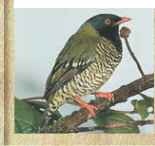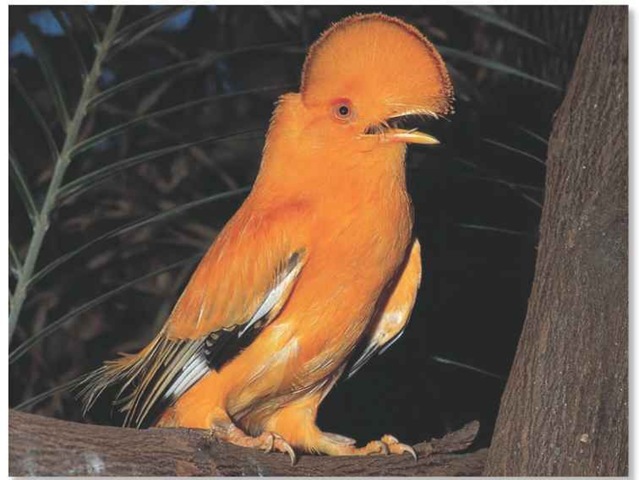ORDER
Passeriformes
FAMILY
Cotingidae
GENUS & SPECIES
KEY FEATURES
• With dazzling plumage and a unique fanlike crest, the male is a magnificent bird
• To attract a mate, males use bright color, rapid movement and weird sounds
• The female’s drab brown plumage camouflages her as she sits on the nest to incubate the eggs

WHERE IN THE WORLD!
Inhabits lowland forests in northeast South America, from French Guiana west to eastern Colombia and south to northern Brazil; occurs at up to 6,600′ in Venezuela
Lifecycle
As superbly colored as the female is dull, the male Guianan cock-of-the-rock leads a solitary, “bachelor” lifestyle away from the display grounds where these two birds meet.
Habitat
The Guianan cock-of-the-rock inhabits undergrowth and midlevels of dense rainforest that cover much of the lowlands of northeastern South America. It favors areas where rivers wind through the forest and rocky outcrops thrust up through the canopy. Here the bird finds the fruit on which it feeds and the rocks on which it builds its nest.
In the breeding season, the gaudy male cock-of-the-rock seeks forest clearings, where its spectacular displays can be easily witnessed by the modestly plumaged females. Females also make frequent trips to the banks of forest streams, which provide them with the soft mud they use to construct their nests.
In the thick of it Mature forest is home to the cock-of-the-rock.
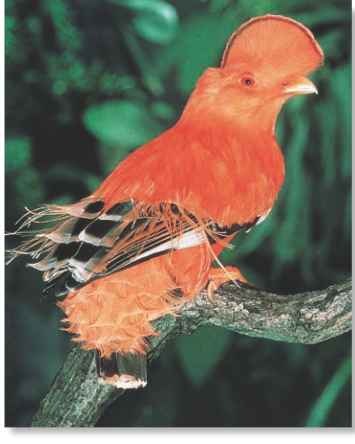
Food & feeding
Foraging alone, the cock-of-the-rock flies unobtrusively through the forest, deftly plucking fruit off branches as it goes. Fruit dominates its diet and one scientific study showed that the cock-of-the-rock feeds on the fruits of as many as 26 different plant species. Most are rich in fats and proteins and are an excellent source of nutrition. Some studies suggest that occasionally the cock-of-the-rock supplements its diet of fruit with insects and small frogs snatched from the foliage.
Breeding

A Single parent
The female builds the nest and raises the chicks alone.
In the weeks prior to breeding, a female builds or renovates her nest. This is a saucer-shaped construction of mud, sticks and other vegetation that she attaches to a sheer rock face, sheltered from the weather and safe from predators. Due to the shortage of suitable nest sites, many birds may nest together.
After mating, the female lays two eggs (about two days apart) and incubates them alone for about four weeks. During this period, she spends up to three-quarters of each day on the nest, only leaving the eggs (for up to ten minutes at a time) to feed. The chicks are fed on regurgitated fruit, but little else is known about their development.
According to the angle at which light hits his plumage, the male cock-of-the-rock appears gold, red or bronze.
The male’s specially modified primary wing feathers produce a whistling sound on take off and landing.
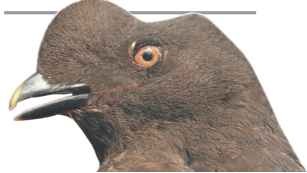
Fruitful The bird uses its sturdy bill to feed on a wide variety of nutritious fruit.
Behavior
In March and April, males gather in forest clearings at communal display grounds, known as leks. Each male has his own “arena,” a circular patch of bare ground a couple of feet in diameter, above which are display perches. His performance in this arena will determine whether or not he wins a mate.
Flaunting their iridescent plumage and uttering crowlike caws, catlike meows and strange cracking sounds, males perform to the females drawn to the spectacle. Usually 5-10 males share the lek, but where population densities are high, as many as 40 may participate in the vigorous dancing sessions.
showdown
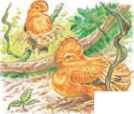
Dramatic entrance…
A mature male cock-of-the-rock arrives at the display ground, or lek, landing with a flourish and a loud squawk.
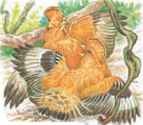
Sizing each other up…
The new arrival is challenged by another male; the pair engage in a brief threat display, exposing their striking white wingbars.
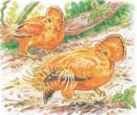
Let the show begin…
Assembled males then start to dance, assuming grotesque postures to show off their plumage to females in the trees.
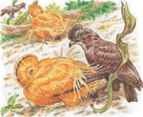
Take your partners
After the display reaches its climax, the males crouch motionless for several minutes. Each female then approaches her chosen mate.
Conservation
The cock-of-the-rock is under no serious threat and is locally common in parts of Suriname. But as with all rainforest birds, it’s vulnerable to forest clearance. It’s also sought by cagebird collectors, despite the fact that most captured birds die soon after they’re caught.
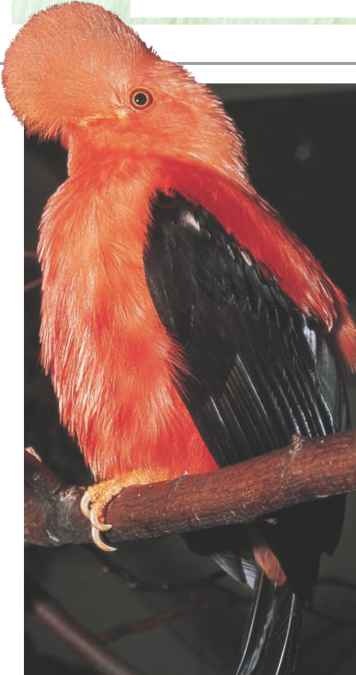
PROFILE
Guianan cock-of-the-rock
The fiery colored and ostentatiously crested male cock-of-the-rock appears quite unrelated to the duller females his plumage is intended to impress.
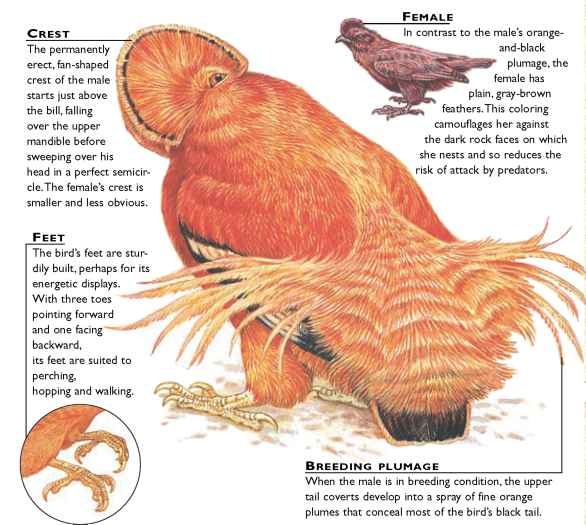
Creature comparisons
The Andean cock-of-the-rock (Rupicola peruviana) is found at higher altitudes than the Guianan species, along forested streams in the Andes (from Venezuela to Peru). Its gray-and-black wings and tail contrast with its deep-red (almost scarlet) body plumage.The Guianan species has an erect, vertical crest; the Andean species’ crest falls to one side of its bill and forehead. Both are shy and live in dense vegetation: their loud calls are usually the only sign of their presence. Unlike its relative, the Andean specie performs its courtship display on a tree branch.
Andean cock-of-the-rock
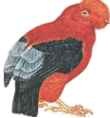
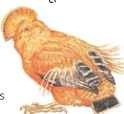
Guianan
cock-of-the-rock
| VITAL STATISTICS | |
| Weight | 5 oz. |
| Length | 11″ |
| WINGSPAN | Unknown |
| Sexual Maturity | Probably ’2-3 years |
| Breeding Season | March-July |
| Number of Eggs | 2 |
| Incubation period | 27-28 days |
| Fledging Period | Unknown |
| Typical Diet | Forest fruits; also some insects and frogs |
| Lifespan | Unknown |
RELATED SPECIES
• Cocks-of-the-rock in the genus Rupicola are two of 65 species in the family Cotingidae. Most cotingas, such as the barred fruiteater (below), have distinctive plumage. Many have crests or bare skin patches on the head.
